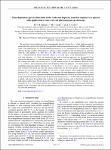Item Infomation

| Title: |
| Time-dependent spectral functions of the Anderson impurity model in response to a quench with application to time-resolved photoemission spectroscopy |
| Authors: |
| Nghiem, H. T. M. Dang, H. T. Costi, T. A. |
| Issue Date: |
| 2020 |
| Publisher: |
| APS |
| Abstract: |
| We investigate several definitions of the time-dependent spectral function A(ω,t) of the Anderson impurity model following a quench and within the time-dependent numerical renormalization group (TDNRG) method. In terms of the single-particle two-time retarded Green function Gr(t1,t2), the definitions we consider differ in the choice of the time variable t with respect to t1 and/or t2 (which we refer to as the time reference). In a previous study [H. T. M. Nghiem et al., Phys. Rev. Lett. 119, 156601 (2017)], we investigated the spectral function A(ω,t), obtained from the Fourier transform of Im[Gr(t1,t2)] with respect to the time difference t′=t1−t2, with time reference t=t2. Here, we complement this work by deriving expressions for the retarded Green function for the choices t=t1 and the average, or Wigner, time t=(t1+t2)/2, within the TDNRG approach. We compare and contrast the resulting A(ω,t) for the different choices of time reference. While the choice t=t1 results in a spectral function with no time dependence before the quench (t<0) (being identical to the equilibrium initial-state spectral function for t<0), the choices t=(t1+t2)/2 and t=t2 exhibit nontrivial time evolution both before and after the quench. Expressions for the lesser, greater, and advanced Green functions are also derived within TDNRG for all choices of time reference. The average-time lesser Green function G<(ω,t) is particularly interesting, as it determines the time-dependent occupied density of states N(ω,t)=G<(ω,t)/(2πi), a quantity that determines the photoemission current in the context of time-resolved pump-probe photoemission spectroscopy. We present calculations for N(ω,t) for the Anderson model following a quench, and discuss the resulting time evolution of the spectral features, such as the Kondo resonance and high-energy satellite peaks. We also discuss the issue of thermalization at long times for N(ω,t). Finally, we use the results for N(ω,t) to calculate the time-resolved photoemission current for the Anderson model following a quench (acting as the pump) and study the different behaviors that can be observed for different resolution times of a Gaussian probe pulse. |
| URI: |
| https://dlib.phenikaa-uni.edu.vn/handle/PNK/391 |
| Appears in Collections |
| Bài báo khoa học |
ABSTRACTS VIEWS
200
FULLTEXT VIEWS
14
Files in This Item:
